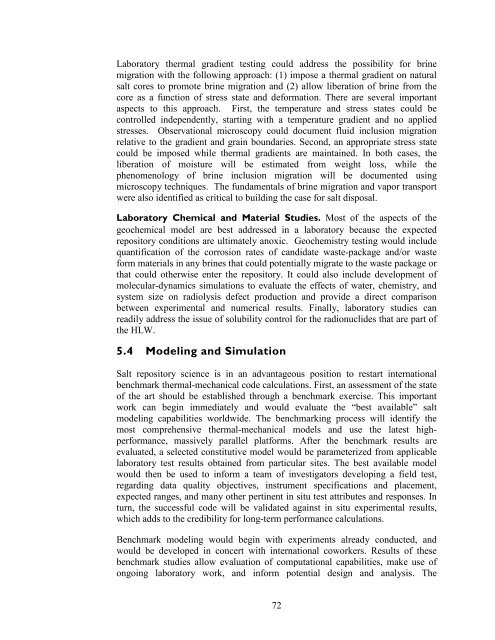Salt Disposal of Heat-Generating Nuclear Waste
Salt Disposal of Heat-Generating Nuclear Waste
Salt Disposal of Heat-Generating Nuclear Waste
You also want an ePaper? Increase the reach of your titles
YUMPU automatically turns print PDFs into web optimized ePapers that Google loves.
Laboratory thermal gradient testing could address the possibility for brine<br />
migration with the following approach: (1) impose a thermal gradient on natural<br />
salt cores to promote brine migration and (2) allow liberation <strong>of</strong> brine from the<br />
core as a function <strong>of</strong> stress state and deformation. There are several important<br />
aspects to this approach. First, the temperature and stress states could be<br />
controlled independently, starting with a temperature gradient and no applied<br />
stresses. Observational microscopy could document fluid inclusion migration<br />
relative to the gradient and grain boundaries. Second, an appropriate stress state<br />
could be imposed while thermal gradients are maintained. In both cases, the<br />
liberation <strong>of</strong> moisture will be estimated from weight loss, while the<br />
phenomenology <strong>of</strong> brine inclusion migration will be documented using<br />
microscopy techniques. The fundamentals <strong>of</strong> brine migration and vapor transport<br />
were also identified as critical to building the case for salt disposal.<br />
Laboratory Chemical and Material Studies. Most <strong>of</strong> the aspects <strong>of</strong> the<br />
geochemical model are best addressed in a laboratory because the expected<br />
repository conditions are ultimately anoxic. Geochemistry testing would include<br />
quantification <strong>of</strong> the corrosion rates <strong>of</strong> candidate waste-package and/or waste<br />
form materials in any brines that could potentially migrate to the waste package or<br />
that could otherwise enter the repository. It could also include development <strong>of</strong><br />
molecular-dynamics simulations to evaluate the effects <strong>of</strong> water, chemistry, and<br />
system size on radiolysis defect production and provide a direct comparison<br />
between experimental and numerical results. Finally, laboratory studies can<br />
readily address the issue <strong>of</strong> solubility control for the radionuclides that are part <strong>of</strong><br />
the HLW.<br />
5.4 Modeling and Simulation<br />
<strong>Salt</strong> repository science is in an advantageous position to restart international<br />
benchmark thermal-mechanical code calculations. First, an assessment <strong>of</strong> the state<br />
<strong>of</strong> the art should be established through a benchmark exercise. This important<br />
work can begin immediately and would evaluate the “best available” salt<br />
modeling capabilities worldwide. The benchmarking process will identify the<br />
most comprehensive thermal-mechanical models and use the latest highperformance,<br />
massively parallel platforms. After the benchmark results are<br />
evaluated, a selected constitutive model would be parameterized from applicable<br />
laboratory test results obtained from particular sites. The best available model<br />
would then be used to inform a team <strong>of</strong> investigators developing a field test,<br />
regarding data quality objectives, instrument specifications and placement,<br />
expected ranges, and many other pertinent in situ test attributes and responses. In<br />
turn, the successful code will be validated against in situ experimental results,<br />
which adds to the credibility for long-term performance calculations.<br />
Benchmark modeling would begin with experiments already conducted, and<br />
would be developed in concert with international coworkers. Results <strong>of</strong> these<br />
benchmark studies allow evaluation <strong>of</strong> computational capabilities, make use <strong>of</strong><br />
ongoing laboratory work, and inform potential design and analysis. The<br />
72
















